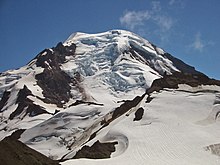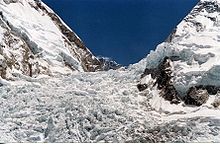| Revision as of 02:34, 16 October 2015 editPharaoh of the Wizards (talk | contribs)Autopatrolled, Extended confirmed users, File movers, Pending changes reviewers, Rollbackers110,054 editsm Reverted edits by 75.156.182.244 (talk) to last revision by Ost316 (HG)← Previous edit | Revision as of 13:50, 30 January 2016 edit undoCwmhiraeth (talk | contribs)Autopatrolled, Administrators138,707 edits Lead addedNext edit → | ||
| Line 1: | Line 1: | ||
| {{refimprove|date=September 2015}} | {{refimprove|date=September 2015}} | ||
| ], ], U.S.]] An '''icefall''' is a portion of |
], ], U.S.]] An '''icefall''' is a portion of certain ]s characterized by rapid flow and a chaotic ]ed surface. The term ''icefall'' is formed by analogy with the word ''waterfall'', a similar, but much higher speed, phenomenon. When ice movement is faster than elsewhere, because the glacier bed steepens or narrows, the flow cannot be accommodated by plastic deformation and the ice fractures, forming crevasses. Where two fractures meet, ]s (ice towers) can be formed. When the movement of the ice slows down, the crevasses can coalesce, resulting in the surface of the glacier becoming smoother. | ||
| ==Ice flow== | |||
| Most glacier ice flows at speeds of a few hundred metres per year or less. However, the flow of ice in an icefall may be measured in kilometres per year. Such rapid flow cannot be accommodated by plastic deformation of the ice. Instead, the ice fractures forming ]s. Intersecting fractures form ice columns or ]s. These processes are imperceptible for the most part; however, a serac may collapse or topple abruptly and without warning. This behavior often poses the biggest risk to ] climbing in an icefall. | Perhaps the most conspicuous consequence of glacier flow, icefalls occur where the glacier bed steepens and/or narrows. Most glacier ice flows at speeds of a few hundred metres per year or less. However, the flow of ice in an icefall may be measured in kilometres per year. Such rapid flow cannot be accommodated by plastic deformation of the ice. Instead, the ice fractures forming ]s. Intersecting fractures form ice columns or ]s. These processes are imperceptible for the most part; however, a serac may collapse or topple abruptly and without warning. This behavior often poses the biggest risk to ] climbing in an icefall. | ||
| Below the icefall, the glacier bed flattens and/or widens and the ice flow slows. Crevasses close and the glacier surface becomes much smoother and easier to traverse. | Below the icefall, the glacier bed flattens and/or widens and the ice flow slows. Crevasses close and the glacier surface becomes much smoother and easier to traverse. | ||
| ==Examples== | |||
| ], ].]]Icefalls vary greatly in height. The ] icefall, on the north face of ] (], U.S.), is about 730 metres (2,400 ft) high (photograph at right). The ice cliff of the left side of the ice fall and above the debris covering the glacier is 20 to 40 metres (70 to 140 ft) high. Typical of mountain glaciers, this icefall forms as the ice flows from a high elevation plateau or basin accumulation zone to a lower valley ablation zone. Much larger icefalls may be found in the outlet glaciers of continental ]s. The icefall feeding the ] in Antarctica (photograph at left) is 7 kilometres (4.4 mi) wide and 14 kilometres (9 mi) long, even though the elevation difference is only 400 metres (1,300 ft), a little more than half that of the Roosevelt Glacier icefall. | ], ].]]Icefalls vary greatly in height. The ] icefall, on the north face of ] (], U.S.), is about 730 metres (2,400 ft) high (photograph at right). The ice cliff of the left side of the ice fall and above the debris covering the glacier is 20 to 40 metres (70 to 140 ft) high. Typical of mountain glaciers, this icefall forms as the ice flows from a high elevation plateau or basin accumulation zone to a lower valley ablation zone. Much larger icefalls may be found in the outlet glaciers of continental ]s. The icefall feeding the ] in Antarctica (photograph at left) is 7 kilometres (4.4 mi) wide and 14 kilometres (9 mi) long, even though the elevation difference is only 400 metres (1,300 ft), a little more than half that of the Roosevelt Glacier icefall. | ||
Revision as of 13:50, 30 January 2016
| This article needs additional citations for verification. Please help improve this article by adding citations to reliable sources. Unsourced material may be challenged and removed. Find sources: "Icefall" – news · newspapers · books · scholar · JSTOR (September 2015) (Learn how and when to remove this message) |

An icefall is a portion of certain glaciers characterized by rapid flow and a chaotic crevassed surface. The term icefall is formed by analogy with the word waterfall, a similar, but much higher speed, phenomenon. When ice movement is faster than elsewhere, because the glacier bed steepens or narrows, the flow cannot be accommodated by plastic deformation and the ice fractures, forming crevasses. Where two fractures meet, seracs (ice towers) can be formed. When the movement of the ice slows down, the crevasses can coalesce, resulting in the surface of the glacier becoming smoother.
Ice flow
Perhaps the most conspicuous consequence of glacier flow, icefalls occur where the glacier bed steepens and/or narrows. Most glacier ice flows at speeds of a few hundred metres per year or less. However, the flow of ice in an icefall may be measured in kilometres per year. Such rapid flow cannot be accommodated by plastic deformation of the ice. Instead, the ice fractures forming crevasses. Intersecting fractures form ice columns or seracs. These processes are imperceptible for the most part; however, a serac may collapse or topple abruptly and without warning. This behavior often poses the biggest risk to mountaineers climbing in an icefall.
Below the icefall, the glacier bed flattens and/or widens and the ice flow slows. Crevasses close and the glacier surface becomes much smoother and easier to traverse.
Examples

Icefalls vary greatly in height. The Roosevelt Glacier icefall, on the north face of Mount Baker (Cascade Range, U.S.), is about 730 metres (2,400 ft) high (photograph at right). The ice cliff of the left side of the ice fall and above the debris covering the glacier is 20 to 40 metres (70 to 140 ft) high. Typical of mountain glaciers, this icefall forms as the ice flows from a high elevation plateau or basin accumulation zone to a lower valley ablation zone. Much larger icefalls may be found in the outlet glaciers of continental ice sheets. The icefall feeding the Lambert Glacier in Antarctica (photograph at left) is 7 kilometres (4.4 mi) wide and 14 kilometres (9 mi) long, even though the elevation difference is only 400 metres (1,300 ft), a little more than half that of the Roosevelt Glacier icefall.
Icefalls are climbed because of their beauty and the challenge they pose. In some cases, an icefall may provide the only feasible or the easiest route up one face of a mountain. An example is the Khumbu Icefall on the Nepalese side of Mount Everest, variously described as "treacherous" and "dangerous." It is about 5,500 metres (18,000 ft) above sea level.


References
- Post, Austin; Edward R. LaChapelle (May 2000) . Glacier Ice (Revised ed.). Seattle, Washington: University of Washington Press. pp. 18–21. ISBN 0-295-97910-0.
{{cite book}}: Cite has empty unknown parameters:|month=and|chapterurl=(help)
| Glaciers | |||||||
|---|---|---|---|---|---|---|---|
| Types | |||||||
| Anatomy | |||||||
| Processes | |||||||
| Measurements | |||||||
| Volcanic relations | |||||||
| Landforms |
| ||||||
| Related | |||||||